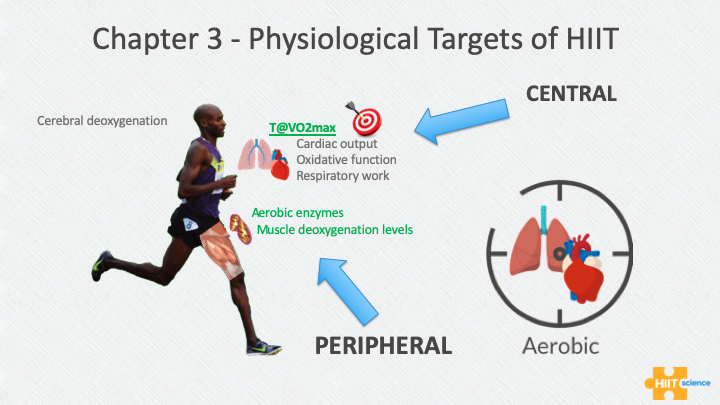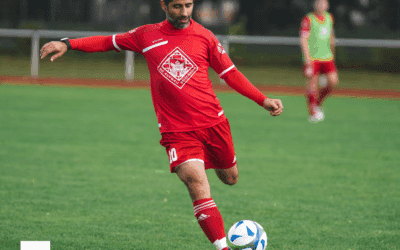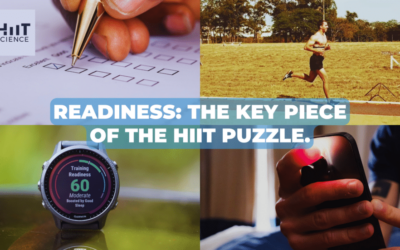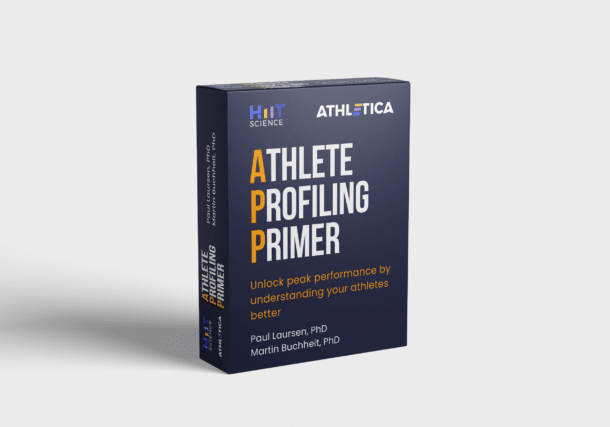A
logical approach to physiological targeting with HIIT is well described throughout HIIT Science. We know that development of our
biological targets (aerobic, anaerobic, neuromuscular) can be stimulated with the right type of training, alongside alignment with the particularities of our
context (e.g. athlete profile, sport demands, environmental constraints). This is the
bird’s eye view that the coach will want to take to form their decisions regarding HIIT prescription.
Most sports we play have a high demand for aerobic energy, so HIIT is often used to develop its capacity
1. We can investigate the aerobic system by measuring the body’s oxygen consumption during exercise. In particular, we like to know the maximal capacity of this system, termed VO
2max, as it is often a key predictor of endurance performance
2.
VO
2max has both central and peripheral components (Figure 1). Central components refer mainly to the cardiac output, or the heart and lungs’ ability to deliver O
2 to the exercising muscles, and often we find this to be the main determinant of VO
2max within the context of many endurance sports
3. Peripheral components refer mainly to the muscles’ ability to extract and use the delivered O
2 (Figure 1).

Figure 1. Central and peripheral aerobic oxidative targets of HIIT.
To gain insight into the peripheral VO
2 component, technological advancements in the form of a non-invasive method called near-infrared spectroscopy (NIRS) have arisen. NIRS can be used to non-invasively estimates a muscle’s oxygenation level by measuring the light refraction level at a muscle bed’s periphery (Figure 2)
4.

Figure 2. Experimental set-up.
Due to the relatively smaller upper-body muscle mass associated with sprint kayak
5, it has been suggested that the peripheral O
2 component may be the stronger determinant of performance versus central aspects per se (Figure 1)
6. While much research has described the refining of HIIT sessions to improve VO
2max via central adaptations, relatively less research has examined peripheral VO
2 targeting with HIIT. In terms of attempts to maximize the central VO
2 component, time during a HIIT session spent near VO
2max (T@VO
2max; Figure 1) has been the focus for attempting to improve the marker
7. Similarly, we hypothesized that a session inducing large fluctuations of peripheral muscle oxygenation, measured via NIRS would be an effective means for targeting peripheral adaptations.
In our recently published
open-access study, we compared the peripheral O
2 response across 4 different HIIT sessions, in order to gain insight into those that would have the potential to maximally induce peripheral deoxygenation, and inferred subsequent resulting adaptations. Our HIIT sessions included two short interval sessions (HIIT-15: 15s/15s and HIIT-30: 30s/30s effort/rest durations), a sprint interval training session (SIT: 6 x 30s/4min30) and a hybrid session, involving long all-out intervals (HIIT-60: 6x1min/3min). All sessions were performed by trained kayakers or canoeists, on a kayak or canoe ergometer (see Table 1).
Table 1. Session name with descriptive details used for the study.
| Session name |
Session description |
| HIIT-15 |
2 sets of 20 x 15s at 110% PPO, 15 s at 30% PPO, 5 min rest between sets |
| HIIT-30 |
2 sets of 10 x 30 at 110% PPO, 30 s at 30% PPO, 5 min rest between sets |
| HIIT-60 |
6 x 1min at 130% PPO, 4 min rest (active or passive) |
| SIT |
6 x 30s all-out, 4min30 rest (active or passive) |
Main results
Let’s begin by having a look at the central response across these varied HIIT sessions, in terms of the accumulated time at a near-maximal cardiac output and maximal heart rate (Table 2).
Table 2. Central response during HIIT
| Session |
HIIT-15 |
HIIT-30 |
HIIT-60 |
SIT |
|
8.1 ± 6.2* |
6.8 ± 4.6* |
4.1 ± 1.7 |
1.7 ± 1.3 |
| Cumulated time near maximal
cardiac output (min) |
5.6 ± 4.4* |
4.0 ± 2.9* |
2.0 ± 1.9 |
1.5 ± 1.6 |
| Cumulated time near maximal
heart rate (min) |
16.6 ± 2.6*$ |
13.7 ± 3.3*$ |
5.3 ± 2.3 |
3.6 ± 1.5 |
$different from HIIT-60 (p<0.05), *different from SIT (p<0.05)
In alignment with the teachings from Chapter 3 of HIIT Science, short-interval HIIT sessions (HIIT-15, HIIT-30) accumulated the greatest T@VO
2max, heart rate near max and cardiac output near max, suggesting that such sessions clearly stress the central aerobic component. The HIIT-60 session (short HIIT / SIT hybrid) induced substantial T@VO
2max, but a less amount than the short HIIT sessions. The logical conclusion of course is that short interval training is going to be effective HIIT when the primary goal is to induce central adaptations.
Let’s now have a look at the peripheral responses to these sessions (Figure 3, Table 3).

Figure 3. Average muscle oxygenation response in the leg muscle during HIIT, revealing the average muscle oxygenation at the start and end of each effort interval during the 4 HIIT sessions.
Peripheral response during HIIT in terms of the accumulated time at more than 90% of maximal deoxygenation in the
biceps brachii (BB),
latissimus dorsi (LD) and
vastus lateralis (VL).
| Session |
HIIT-15 |
HIIT-30 |
HIIT-60 |
SIT |
| Cumulated time > 90 % deoxy max BB (s) |
7.5 ± 8.6* |
24.7 ± 40.5 |
24.5 ± 26.8 |
44.8 ± 40.0 |
| Cumulated time > 90 % deoxy max LD (s) |
8.7 ± 15.3* |
29.9 ± 24.9 |
33.3 ± 37.3 |
61.2 ± 44.8 |
| Cumulated time > 90 % deoxy max VL (s) |
0.0 ± 0.0* |
0.2 ± 0.6* |
26.5 ± 39.0* |
83.2 ± 63.1 |
*different from SIT (p<0.05)
As we might expect, again from our HIIT Science material (Chapter 3), the SIT session was the only session that induced severe and sustained muscle deoxygenation in the locomotor muscles, suggesting this session substantially stresses the peripheral component of the aerobic target of importance to sprint kayakers. In contrast, our short HIIT sessions only induced mild deoxygenation levels, sustained for < 30 sec, and therefore would be considered less of an appropriate stimulus to induce peripheral adaptations. The HIIT-60 session induced a high, but not severe, muscle deoxygenation.
Practical takeaways for sprint kayak coach and science teams
- Coaches and athletes who wish to improve the central component of VO2max should prescribe short (and long) intervals in their program.
- Assuming that sustained muscle deoxygenation in training is associated with improved peripheral adaptations, then SIT sessions should be chosen to specifically target the peripheral component. These sessions are of interest especially for upper-body dominant sports such as sprint kayak, and additionally other sports that use relatively-small active muscle masses.
- Longer supramaximal intervals could be used to maintain both central and peripheral adaptations or to train these components in lower-level athletes.
- What hasn’t been touched on in this short blog, of course, is the second key physiological target, the anaerobic glycolytic response, and for more insight into maximizing this related and important parameter, the reader is directed to HIIT Science Chapters 3-5.
Conclusion
In conclusion, this study extends on the current list of sports within HIIT Science that can benefit from targeted HIIT programming, and in particular, we focussed on the central and peripheral aerobic components. Coaches of sprint kayak athletes need to choose their HIIT weapon accordingly before their athletes hit the water!
About the authors:

Myriam Paquette is a sport physiologist at the
Institut National du Sport du Québec, working primarily with the para cycling and para swimming national teams. Myriam is completing her PhD at
Université Laval, under the supervision of Dr Billaut and co-supervision of Dr Bieuzen. Follow her on
Facebook.
 Dr François Billaut
Dr François Billaut is a full professor of exercise physiology at
Université Laval where he leads a sports science research program investigating the acute and chronic effects of HIIT and hypoxia on athlete performances. He is also an applied sport scientist for several Canadian national teams.
References
- Buchheit M, Laursen PB. High-intensity interval training, solutions to the programming puzzle: Part I: cardiopulmonary emphasis. Sports medicine 43(5):313-338, 2013.
- di Prampero, P.E. Factors limiting maximal performance in humans. Eur J Appl Physiol 90(3-4):420-9, 2003.
- Bassett DR, Howley ET. Limiting factors for maximum oxygen uptake and determinants of endurance performance. Med Sci Sports Exerc 32(1):70-84, 2000.
- Ferrari M, Muthalib M, Quaresima V. The use of near-infrared spectroscopy in understanding skeletal muscle physiology: recent developments. Philosophical transactions Series A, Mathematical, physical, and engineering sciences 369(1955):4577-4590, 2011.
- Michael JS, Ronney KB, Smith R. The metabolic demands of kayaking: a review. J Sports Sci Med 7(1):1-7, 2008.
- Paquette M, Bieuzen F, Billaut F. Muscle Oxygenation Rather Than VO2max as a Strong Predictor of Performance in Sprint Canoe-Kayak. Int J Sports Physiol Perform 13(10):1-9, 2018.
- Midgley AW, McNaughton LR. Time at or near VO2max during continuous and intermittent running: a review with special reference to considerations for the optimisation of training protocols to elicit the longest time at or near VO2 J Sports Med Phys Fitness 46(1):1-14, 2006.



 Myriam Paquette is a sport physiologist at the Institut National du Sport du Québec, working primarily with the para cycling and para swimming national teams. Myriam is completing her PhD at Université Laval, under the supervision of Dr Billaut and co-supervision of Dr Bieuzen. Follow her on Facebook.
Myriam Paquette is a sport physiologist at the Institut National du Sport du Québec, working primarily with the para cycling and para swimming national teams. Myriam is completing her PhD at Université Laval, under the supervision of Dr Billaut and co-supervision of Dr Bieuzen. Follow her on Facebook.
 Dr François Billaut is a full professor of exercise physiology at Université Laval where he leads a sports science research program investigating the acute and chronic effects of HIIT and hypoxia on athlete performances. He is also an applied sport scientist for several Canadian national teams.
References
Dr François Billaut is a full professor of exercise physiology at Université Laval where he leads a sports science research program investigating the acute and chronic effects of HIIT and hypoxia on athlete performances. He is also an applied sport scientist for several Canadian national teams.
References







